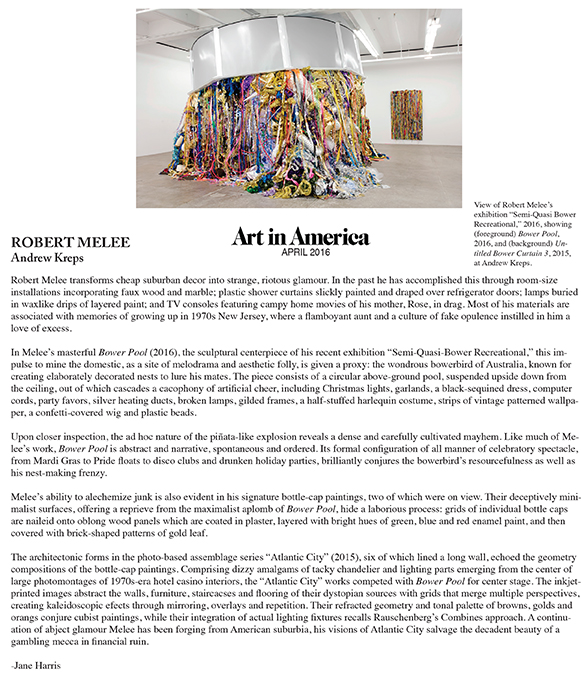
http://www.artinamericamagazine.com/reviews/robert-melee/

Art in review, JAN. 28, 2016
http://www.nytimes.com/interactive/2016/01/29/arts/design/art-galleries-nyc.html?ref=arts&_r=0
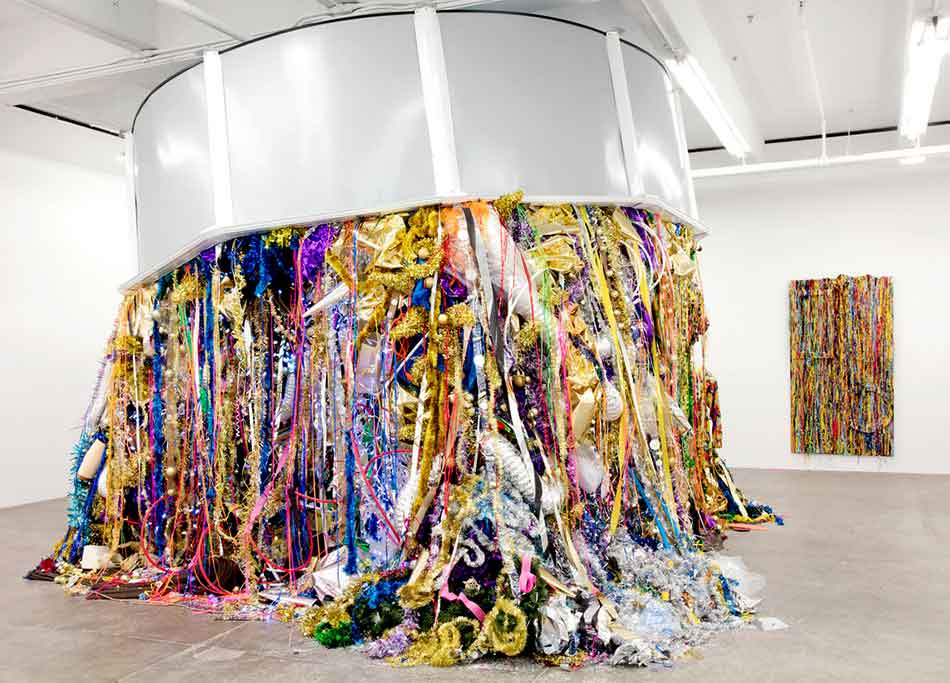
Robert Melee’s “Bower Pool” (2016) is titled after leafy garden areas, but also suggests nightclub debauchery.
|
|
Robert Melee, ‘Semi-Quasi-Bower Recreational’
By MARTHA SCHWENDENER
Susan Sontag once described camp as a vision of the world in terms of style, a form of dandyism in the age of mass culture that relies on private codes of artifice and exaggeration and results in what she called a “good taste of bad taste.” Robert Melee’s current show fits this criteria perfectly. It’s not the camp of Sontag’s era, of the filmmaker Jack Smith’s theatricality or the anesthetized aesthetic of Andy Warhol. Rather, it is camp for the Gallery Age, overrun with glittering objects installed in spaceswhere difference is tolerated, but largely defanged.
“Portrait of Debs With Fans” (2015) is a photomontage featuring the fashion designer David Quinn (also known as Debs), who looks like the drag performer Divine — a mainstay in John Waters’s camp films. In the photos here, Debs is supposedly painting a room but is actually vamping and posing. Inserted laterally into the work are two ceiling fans, perverting both the art object and the idea of functional decoration.
In “Atlantic City” (2015), a series of inkjet photomontages, the imagesdepict mundane scenes inside New Jersey hotels and casinos and have cheap chandeliers jammed into their surfaces. The pièce de résistance, however, is “Bower Pool” (2016), an above-ground pool hung upside downfrom the ceiling, emitting a cascade of streamers, lights, confetti and random objects like a woman’s pantsuit. Titled after leafy, shaded gardenareas, the work is also reminiscent of the nooks in nightclubs where acts of debauchery are performed.
Yet, no debauchery is likely to take place here. This is a gallery, after all — a sterile white-cube space. Still, Mr. Melee achieves Sontag’s camp standard, creating work that is enjoyable, playful and potentially liberating.
Andrew Kreps Gallery
537 West 22nd Street, Chelsea
Through Feb. 16 |
artforum.com Picks
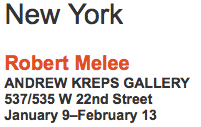
|
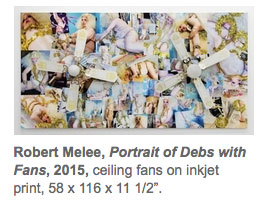 There are a lot of works in Robert Melee’s show, and various kinds of it are mounted on the walls, or, it almost seems, pushed against them by the explosion of Bower Pool, 2016, an overturned above-ground swimming pool that hangs from the gallery’s ceiling, hemorrhaging decorations. The glittery trappings of Christmas, Mardi Gras, birthdays, graduations, and Pride cascade from the backyard tub like a piñata frozen in time at its climax. Or, as per the title, it’s a nest: Bowerbirds decorate with natural baubles and bright garbage to attract mates. There are a lot of works in Robert Melee’s show, and various kinds of it are mounted on the walls, or, it almost seems, pushed against them by the explosion of Bower Pool, 2016, an overturned above-ground swimming pool that hangs from the gallery’s ceiling, hemorrhaging decorations. The glittery trappings of Christmas, Mardi Gras, birthdays, graduations, and Pride cascade from the backyard tub like a piñata frozen in time at its climax. Or, as per the title, it’s a nest: Bowerbirds decorate with natural baubles and bright garbage to attract mates.
In hotels, restaurants, and sometimes homes, ornamental panels with aesthetic purpose waver in status between artwork, decoration, and fixture. Much of Melee’s attractive work has that ambiguous presence. His “Inter Guilded Semi-Quasi Substitution” pieces (all works 2015) have a high-end modern-décor, puzzle-piece feel (“Polynesian” in a Brady Bunch way); the “Untitled Bower Curtain” paintings are bubblegummy, confetti-based takes on drippy high modernism with a dash of your mom’s friend’s fiber art; and the “Atlantic City” wall-mounted photosculptures, made from images of hotel lobbies and casinos, actually incorporate light fixtures. The latter are the least friendly pieces, with the hardware and glass of chandeliers jutting out from the folded space of angular photocollages. Portrait of Debs with Fans is similarly disorienting, featuring two cheap ceiling fans. As the only portrait, it’s a revealing wildcard. In a storyboard-like collage, fashion designer David Quinn, in boudoir maquillage and various states of undress, appears haphazardly wielding a paintbrush. Like a lonely bowerbird working to seduce with what he can find, he manages to pull things together—or rather, Melee does, perfectly, matching Quinn’s tinsel garland to the fans’ fake-fancy gold accents.
— Johanna Fateman |
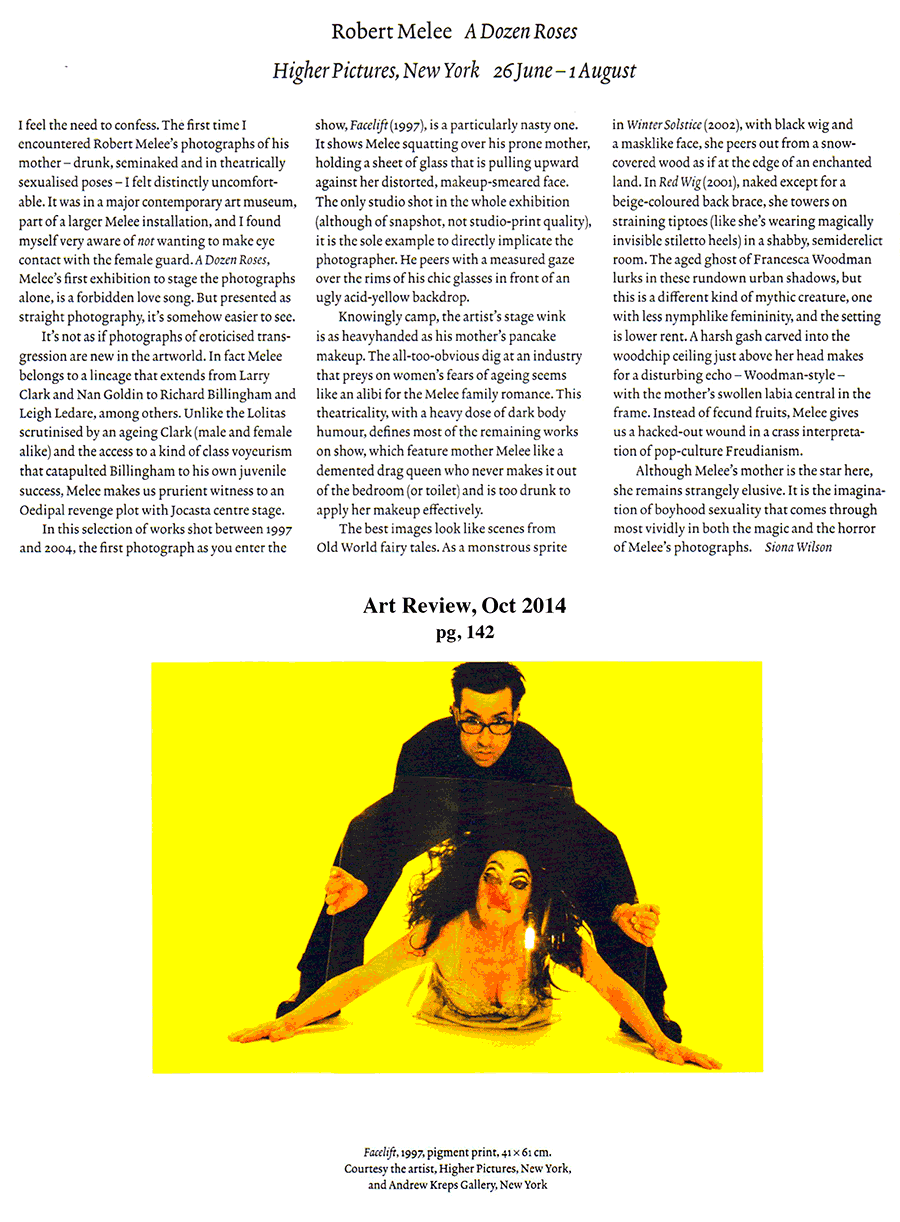
The Huffington Post 12/08/2014
Mommy Dearest: An Interview With Robert Melee
by Jane Harris
http://www.huffingtonpost.com/jane-harris/mommy-dearest-an-intervie_b_6278106.html
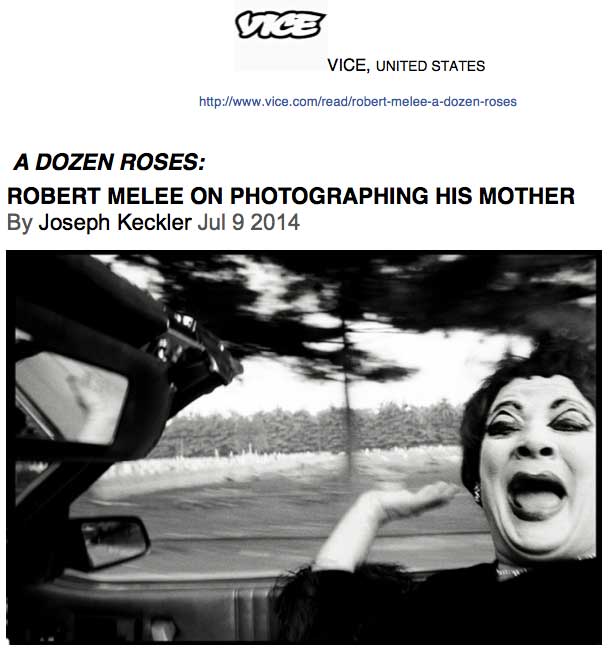
|
Robert Melee often embeds an element of the everyday or personal even in his most purely formal pieces. For instance, his paintings on beer-bottle caps set in plaster, which are serious explorations of color, still prompt one to wonder, in the midst of aesthetic admiration, Did he drink all those beers himself? In his multimedia body of work, Melee has used fake wood paneling, silver platters, tinsel, footage of sexual intercourse, footage of an unsuspecting drunk stranger shot through a peephole, liquid cheese food, party hats, his friends, himself, and, in what may be his best-known works, his mother.
As the exhibition title suggests, a dozen Roses, on view at Higher Pictures through August 1st, features twelve images of Melee’s mother, Rose. In these photographs, chosen from an extensive series the artist completed between 1993 and 2004, we encounter the subject engaged in an array of peculiar scenes. In one arresting photograph, she stands naked in a snowy forest wearing thick eyeliner, with her lips blackened and face powdered white. In another, she is dolled up like a drag queen, whooping it up in the passenger seat of a convertible, on a joyride through the cemetery. We also witness her posing on all fours, stationed atop a kitchen table in a slutty negligee with some pots, pans, and a teakettle piled on her back.
I spoke with Robert about the genesis of this work, what it’s like to return to it, and how he got his mother to cooperate in the first place.
VICE: I guess we met at a salon of Matthu Placek's in 2011 and then later that year you invited me to perform at your opening at Andrew Kreps, and I gradually got to know you more after that. I missed the original shows involving your mother, so it's exciting to see this one.
Robert Melee: Yes, we met at one of Matthu’s salons.
VICE: In the past, these works were shown among installations, videos, and sometimes even your mother herself, in the flesh. How does it feel to revisit these images at this point and view them purely as photographs?
RM: When I was experimenting with photographs and videos in the very early 90s, I knew they were going to be one of many elements in my sculptures. I haven’t taken any photos of my mother in more than a decade, but I have been putting together a monograph of this work over the past year. I’ve never had an exhibition of individually framed photos. But it seemed only natural to show these after finishing the book, so I approached Higher Pictures to see if they might be interested in showing the work, and I’m grateful that they were. I’m very excited about giving them a new life.
VICE: How did you first approach your mother about participating? Did you just say, "Slap some makeup on that face and take off your clothes, Mom; we're going to the woods," or what? And was she gung ho from the get-go, or resistant?
RM: After my first installation, Baloneyism, which consisted of plastic-slip-covered painted furniture, refrigerator doors, a shag carpet soaked with 20 gallons of latex enamel paint, and walls lined with painted imitation wood, I didn’t want to repeat the process, but I did want to continue with the context.
VICE: Of the suburban domestic interior?
RM: Yes. So I abandoned the solitude of object-making in the studio, and for more than two years I shot "snapshots" and "home movies" of close friends, acquaintances, strangers, and my mother. I first approached my mother during a visit to her home. I asked if I could take some pics for a project, and she agreed. This first shoot took 15 minutes. The results were so strong, and we were both so relaxed, that I shot more—she would visit or I would visit her, we’d have some drinks, and I would apply makeup and dress her and see what would happen. It was the second shoot, when she visited me in New York, that she decided it would be more interesting if she took her clothes off. How could I argue?
VICE: Did she have a good time? Did you?
RM: Her entire personality would change once I finished hair and makeup. She became very flamboyant. I think she really loved the attention and the glam of the photo shoot. To this day she thanks me for all the great and interesting situations we have gotten into.
The shoots were never discussed beforehand, and we never brainstormed. These shoots were very intimate—no one else on set. I did all makeup and costume and juggled still and video cameras, and used a tripod when called for.
When I showed her the results, she would critique the work like a producer: “The legs are great in this one,” or “The wig is crazy in this one.” Even of the most unflattering and disturbing image, she would say, “They’re going to love this one. This one will sell.”
VICE: The press release indicates she was drunk in all the photos. Was that a restriction of the series, or did it just happen that way? Were you drunk too?
RM: My mother, now 79, rarely drinks these days. The shoots were always scheduled around visits, and we both liked to drink at the time. It always helped relax my mother before she’d hear me say, for example, “I would like to film me giving you a bath."
When I had my Talent Show at the Kitchen, I met my mother at Penn two hours before curtain call. We had a few drinks at the station and hopped in a taxi directly to the venue. I told her I wanted to show her something. Then I showed her the stage I had designed and told her that we were the first performance—that she would have to take off her clothing and I was going to pour paint on her, to match the set design, in front of a live audience. She was like, "What?" But within seconds she agreed to do it, two nights in a row. The first night I walked her backstage to clean up. The second night, at her request, I put a robe on her and we sat in the audience and watched all the other performances with leftover latex paint on her body. She had a ball!
VICE: These photos were taken over the course of more than a decade. How did you know when the series was over? And did you know where you would go next?
RM: The series was over when I had nothing else to say. At that time, I had exhausted most of my ideas with photo and video and not only stopped taking photos and videos of my mother but stopped entirely for about a decade. I started shooting again for my show in 2011. It was then that I started experimenting with green screen. I presented 11 new videos and many new photos for that show. I wanted to make work just as psychologically charged, but less obvious than photo and video. That’s when I began exploring figurative sculpture, first shown in my solo show In Between False Comforts, in 2005.
VICE: There are a dozen images featured in this show, but there are many others. How did you select this particular set of twelve?
RM: There are over 300 images from this body of work, so it wasn't easy choosing. Higher Pictures and I decided to present a variety of the images from twelve different shoots, instead of forming a narrative.
VICE: To make a parent a subject of your work is to put them into a world where you can control them, on one level. You might be looking for connection, reconciliation, revenge, catharsis... Or maybe a psychological reading like this is reductive or somehow inappropriate to the work. Do you have anything to say about what compelled you to do work around, and with, your mother?
RM: Let's just say it was very interesting being raised by such a woman. There were some serious difficulties, and by the time I was a late teen, we weren’t really talking much. It was through this work that we became close again. The shoots were like therapy sessions. Makeup that normally took me 20 minutes to apply took me two hours because Mommy could talk! This became routine. She would tell me some of her childhood experiences that were very personal, which explained her method of raising children. She would ask for forgiveness, so I forgave her, to the best of my abilities.
These photos are exaggerations of her, caricatures. They are my memory of her when she was extremely restless, not afraid to make up—with the courage to wear micro miniskirts and boots to the local strip mall, with baby me in tow.
Her hair color changed monthly, and our home furnishing was rearranged endlessly.
VICE: Now this is not so relevant to the current show, but I am just so curious if anyone hired her the time she was made "available" at a past exhibition?
RM: At the opening of my exhibition You Me and Her, in 2002 in New York, she was placed behind safety glass. She greeted people smoking, drinking, and wearing only a feather boa and heels. This was documented and a video monitor replaced her in that space. I think the price list said she was available for $6,000 an hour. No one purchased time with her.
VICE: What a shame. So a coffee table book is in the works?
RM: Yes, it is basically all laid out, with two essays already written on this work, one by my brother Ed and one by the artist Michael Bilsborough. The working title is Unavailability. I am currently looking for a publisher.
VICE: What is next?
RM: I have started combining my photographs with my plaster and fiberglass works. I have solo shows at David Castillo in Miami and at Andrew Kreps in New York in 2015. We shall see...
Robert Melee: a dozen Roses will be on view at Higher PIctures Gallery through August 1st, 2014.
Joseph Keckler is an interdisciplinary artist, writer, and operatic bass-baritone whom the Village Voice named “Best Downtown Performance Artist" in 2013. Follow him on Twitter. |
Vice, July 2014 |

Modern Painters, Sept 2011


V Magazine, Fall 2011

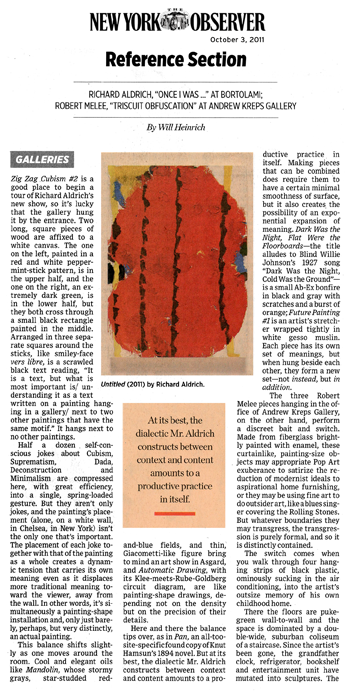 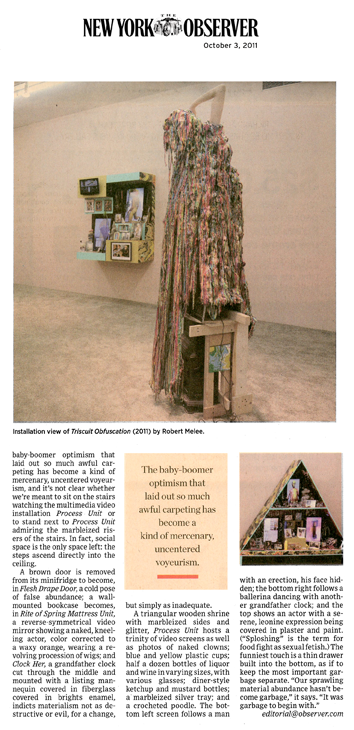
New York Observer, Oct 2011

SVA Bilsborough Blog, Oct 2011 (link)

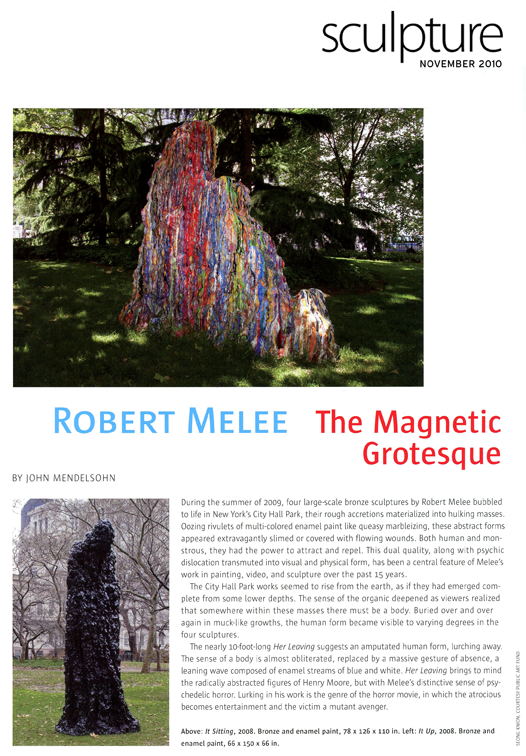 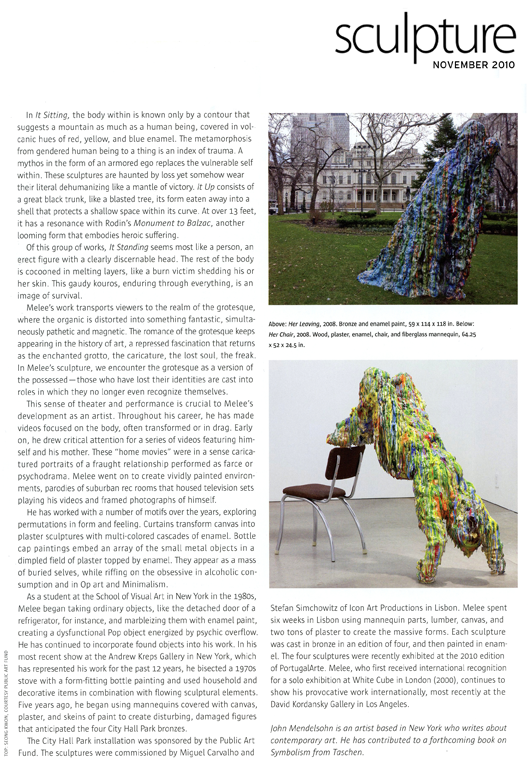
Sculpture Magazine, Nov 2010

SVA Bilsborough Blog, Feb 2009 (link)

New York Times, Dec 2008

SVA Bilsborough Blog, June 2010 (link)


New York Times, Nov 2008


Artforum, Dec 2005


New York Times, Nov, 2005


Time Out NY, Oct 2005


NY Press, June 2005


New York Times, May, 2005


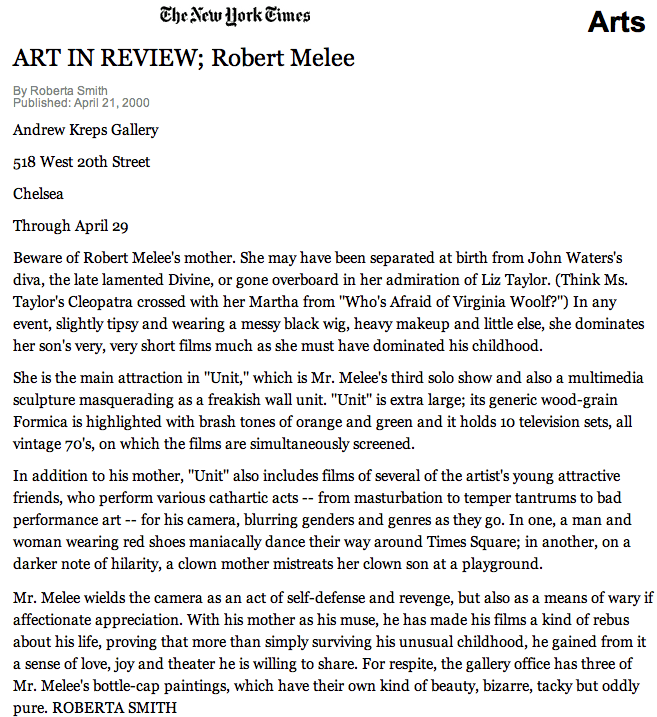

Art Monthly, Sept 2000

|
|









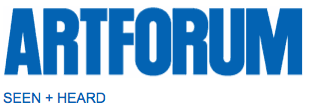

 There are a lot of works in Robert Melee’s show, and various kinds of it are mounted on the walls, or, it almost seems, pushed against them by the explosion of Bower Pool, 2016, an overturned above-ground swimming pool that hangs from the gallery’s ceiling, hemorrhaging decorations. The glittery trappings of Christmas, Mardi Gras, birthdays, graduations, and Pride cascade from the backyard tub like a piñata frozen in time at its climax. Or, as per the title, it’s a nest: Bowerbirds decorate with natural baubles and bright garbage to attract mates.
There are a lot of works in Robert Melee’s show, and various kinds of it are mounted on the walls, or, it almost seems, pushed against them by the explosion of Bower Pool, 2016, an overturned above-ground swimming pool that hangs from the gallery’s ceiling, hemorrhaging decorations. The glittery trappings of Christmas, Mardi Gras, birthdays, graduations, and Pride cascade from the backyard tub like a piñata frozen in time at its climax. Or, as per the title, it’s a nest: Bowerbirds decorate with natural baubles and bright garbage to attract mates.
















